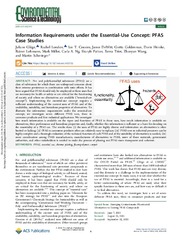Information Requirements under the Essential-Use Concept: PFAS Case Studies
Permanent link
https://hdl.handle.net/10037/23318Date
2021-10-05Type
Journal articleTidsskriftartikkel
Peer reviewed
Author
Glüge, Juliane; London, Rachel; Cousins, Ian T.; Dewitt, Jamie; Goldenman, Gretta; Herzke, Dorte; Lohmann, Rainer; Miller, Mark; Ng, Carla A.; Patton, Sharyle; Trier, Xenia; Wang, Zhanyun; Scheringer, MartinAbstract
Per- and polyfluoroalkyl substances (PFAS) are a class of substances for which there are widespread concerns about their extreme persistence in combination with toxic effects. It has been argued that PFAS should only be employed in those uses that are necessary for health or safety or are critical for the functioning of society and where no alternatives are available (“essential-use concept”). Implementing the essential-use concept requires a sufficient understanding of the current uses of PFAS and of the availability, suitability, and hazardous properties of alternatives. To illustrate the information requirements under the essential-use concept, we investigate seven different PFAS uses, three in consumer products and four industrial applications. We investigate how much information is available on the types and functions of PFAS in these uses, how much information is available on alternatives, their performance and hazardous properties and, finally, whether this information is sufficient as a basis for deciding on the essentiality of a PFAS use. The results show (i) the uses of PFAS are highly diverse and information on alternatives is often limited or lacking; (ii) PFAS in consumer products often are relatively easy to replace; (iii) PFAS uses in industrial processes can be highly complex and a thorough evaluation of the technical function of each PFAS and of the suitability of alternatives is needed; (iv) more coordination among PFAS manufacturers, manufacturers of alternatives to PFAS, users of these materials, government authorities, and other stakeholders is needed to make the process of phasing out PFAS more transparent and coherent.
Publisher
American Chemical SocietyCitation
Glüge, London, Cousins, Dewitt, Goldenman, Herzke, Lohmann, Miller, Ng, Patton, Trier, Wang, Scheringer. Information Requirements under the Essential-Use Concept: PFAS Case Studies. Environmental Science and Technology. 2021Metadata
Show full item recordCollections
Copyright 2021 The Author(s)


 English
English norsk
norsk